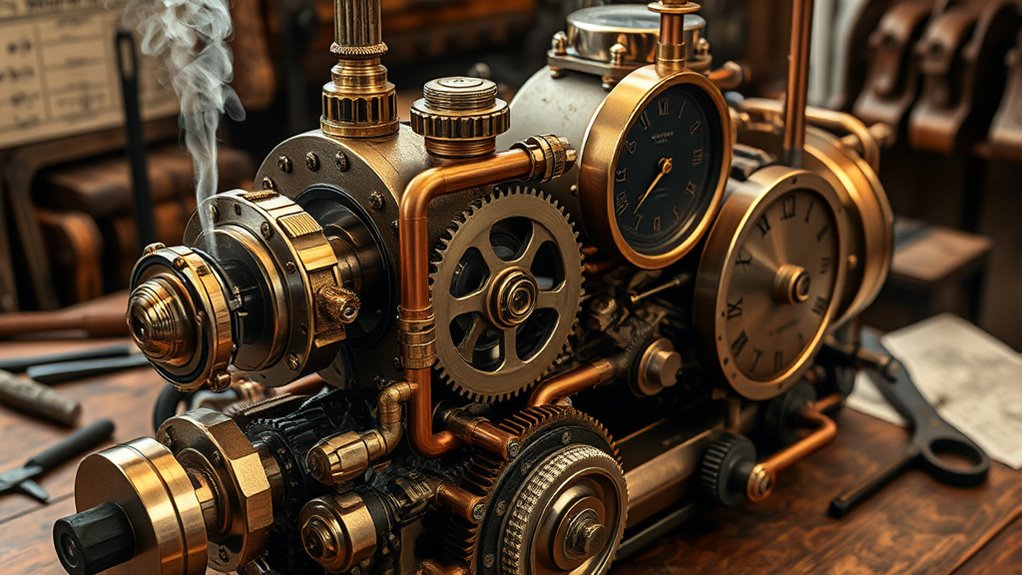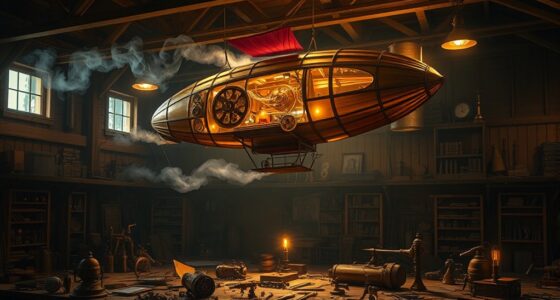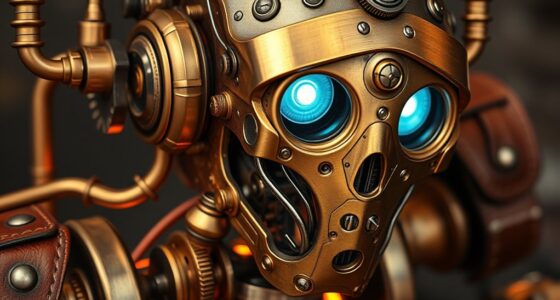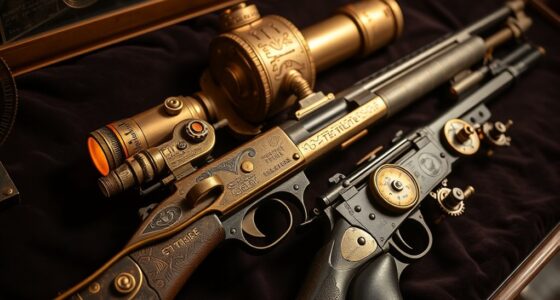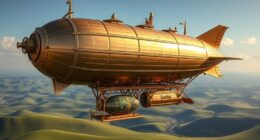Steampunk engineering combines the principles of steam power with Victorian aesthetics. You harness thermal energy through boilers that produce steam, driving intricate machines like airships and automatons. By increasing steam pressure, you raise boiling points, making systems more efficient. Gears, cogs, and valves create captivating devices, merging beauty with functionality. This unique blend of history and innovation shapes the steampunk world. Explore how these elements intertwine and create a rich narrative fabric beyond the surface.
Key Takeaways
- Steampunk engineering harnesses steam power to convert thermal energy into mechanical work, primarily using boilers to generate steam from heated water.
- The Rankine cycle is a fundamental thermodynamic process that optimally utilizes steam to drive turbines, enhancing energy efficiency.
- Key components of steampunk systems include boilers, turbines, and condensers, which work together to maximize steam energy conversion.
- Mechanical automatons in steampunk designs operate through intricate gear and valve mechanisms, showcasing the blend of technology and craftsmanship.
- Anachronistic innovations merge Victorian aesthetics with advanced steam technologies, creating visually striking and functional art pieces in the steampunk genre.
The Fundamentals of Steam Power

When you explore the fundamentals of steam power, you'll find it revolves around converting thermal energy into mechanical work. This process starts by heating water in a boiler, turning it into steam through thermal energy conversion. The energy required to change water from liquid to vapor is called latent heat, which plays a crucial role in heating applications. As steam pressure increases, so does its boiling point, allowing for versatile usage. The Rankine cycle, a thermodynamic cycle, efficiently harnesses steam to drive turbines, generating electricity. Key components like boilers, turbines, and condensers form a closed loop, enhancing energy efficiency. This understanding of steam power aligns with the objectives of the lecture series, which aims to promote best practices within the engineering industry.
The Evolution of Airship Technology
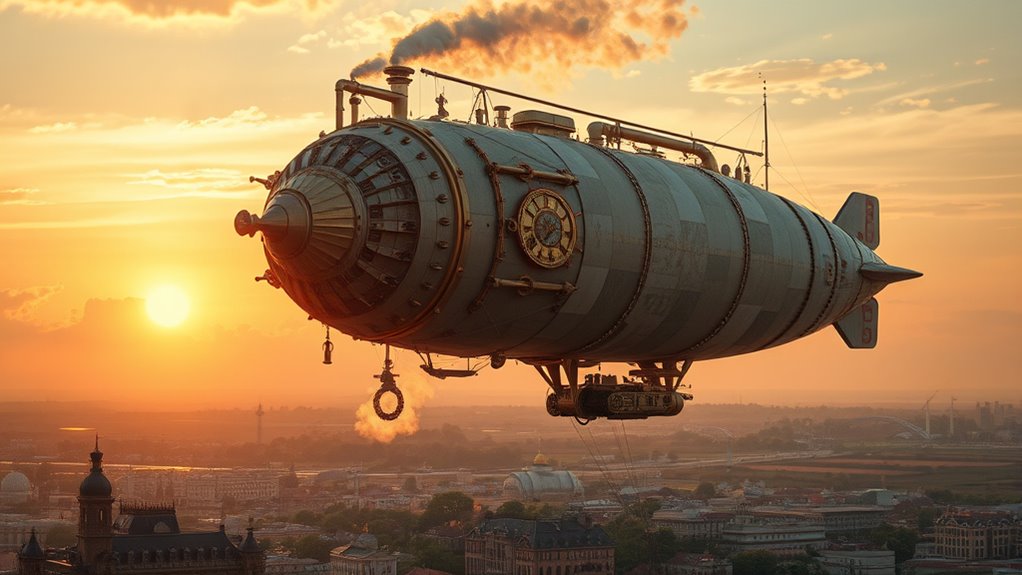
The journey of airship technology began with inspiration drawn from steam power and early ballooning experiments. In 1783, hot air balloons took to the skies, paving the way for innovative designs. By 1784, Jean Baptiste Meusnier envisioned controlled airships with propellers. Henri Giffard made a significant leap in 1852, creating the first powered airship using a steam engine. The *La France* achieved the first fully controlled flight in 1884, showcasing the potential of airships despite their handling challenges. Rigid airships became prevalent in the early 1900s, thanks to Count Zeppelin's contributions, which enhanced speed and stability. These advancements led to military and commercial applications, highlighting airships' evolving role in transportation and exploration. As the need for energy efficiency grew, the principles of heat pump technology began to influence various engineering fields, including airship design. Understanding the refrigeration cycle in heat pumps can provide insights into optimizing airship propulsion systems for improved performance. Additionally, the integration of energy-efficient systems into airship designs could significantly reduce operational costs and environmental impact, as advancements in heat pump technology have shown a potential for decreasing energy consumption by up to 50%.
Mechanical Automatons and Their Functionality
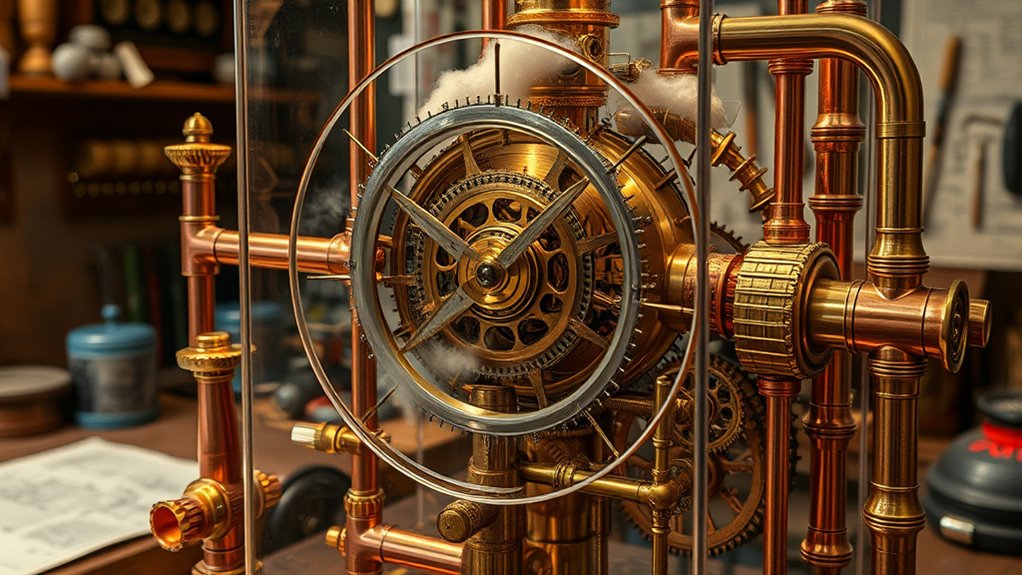
While many view mechanical automatons as mere curiosities, their intricate designs and functionalities reveal a fascinating intersection of art and engineering.
These creations, powered by steam or clockwork mechanisms, can perform tasks ranging from simple to complex. You'll find them in various forms—humanoid or otherwise—often adorned with a Victorian-era aesthetic. Aether can also be utilized as a power source for these automatons, enhancing their capabilities and adding to their mystique.
At their core, gears, cogs, pistons, and valves work in harmony to enable movement and action. Some automatons serve as medical assistants or guards, showcasing their innovative applications.
As you explore their world, you'll notice how these mechanical beings can communicate through sounds or visual cues, and even display quirky personality traits, making them both intriguing and relatable companions in the steampunk narrative landscape.
Anachronistic Innovations in Steampunk
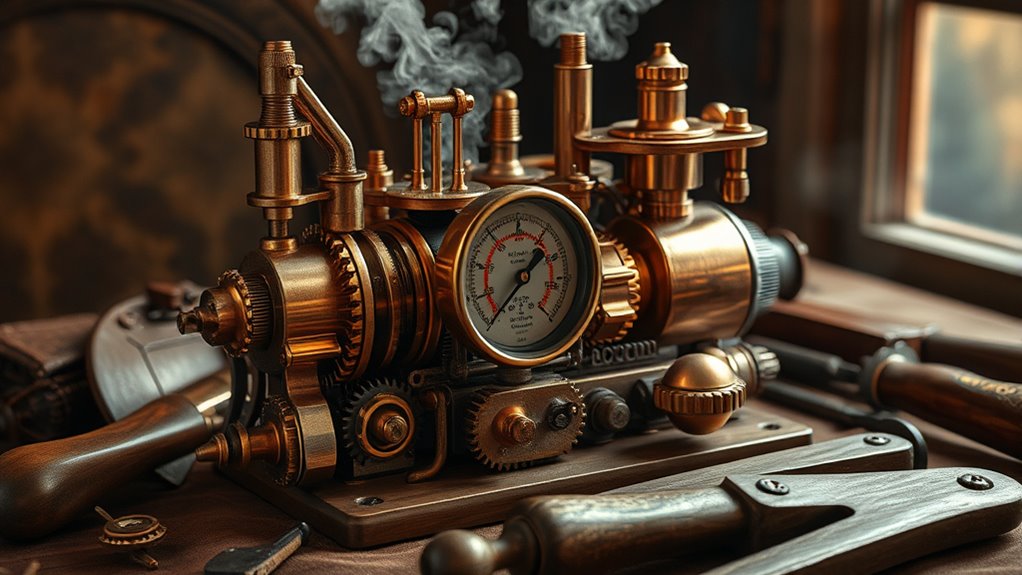
Steampunk's charm lies in its anachronistic innovations, where steam power fuels a world filled with fantastical technologies that never quite came to fruition.
You'll encounter steam engines that drive intricate machinery, airships soaring through alternative skies, and mechanical prosthetics enhancing human abilities. This retro-futuristic vision draws from the Victorian era's aesthetics and the Industrial Revolution's advancements, creating a unique blend of history and imagination. Inspired by the innovative thinking of figures like Charles Babbage, steampunk showcases analog computers and other inventions that existed only in dreams. Additionally, the genre's exploration of alternative history imagines a world dominated by steam power and clockwork technology, further enriching its narrative landscape.
The Aesthetic Appeal of Steampunk Engineering
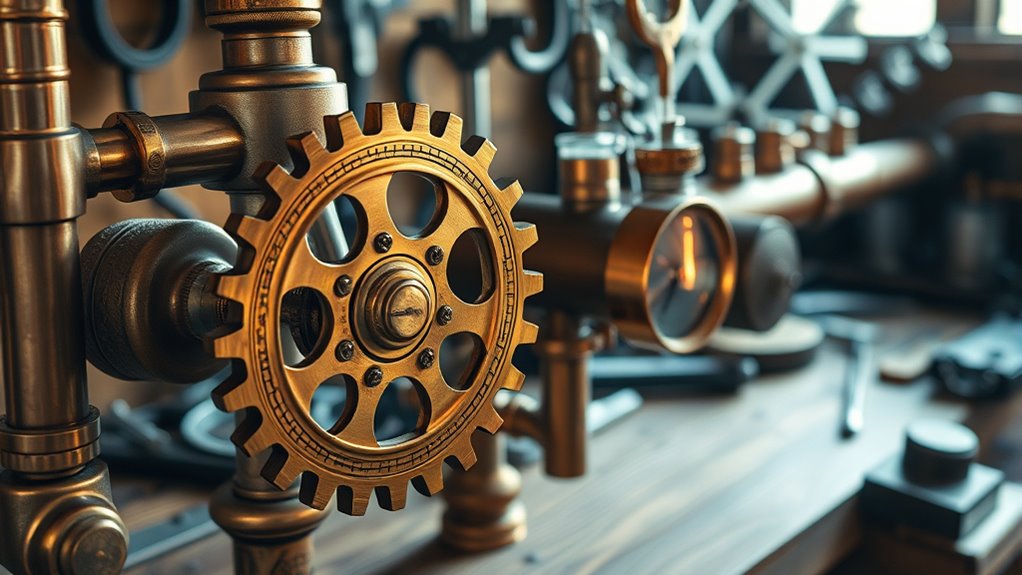
Drawing inspiration from the Victorian and Edwardian eras, steampunk engineering captivates with its blend of elegance and industrial grit.
You'll notice the intricate architecture and ornate fashion that define its aesthetic, enhanced by metals like brass, copper, and steel. This combination creates a striking visual impact that feels both refined and rugged.
Advanced steam-powered technologies merge seamlessly with vintage design, giving life to imaginative creations like airships and clockwork devices. Accessories like goggles and pocket watches symbolize the fusion of these worlds. Steampunk encourages imaginative exploration, allowing artists to push the boundaries of traditional design.
Steampunk's artistic expression often involves upcycling vintage objects, transforming them into functional art pieces. This unique blend not only celebrates the past but also inspires a forward-thinking vision that resonates with creative minds today.
Alternate Historical Settings and Their Impact
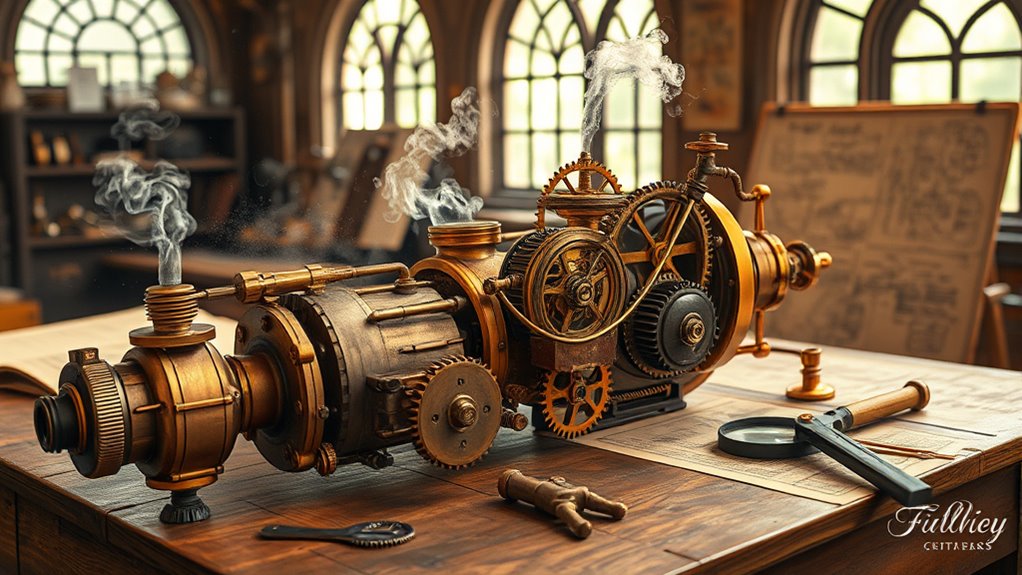
As you delve into the realm of steampunk, you'll discover how alternate historical settings create a rich tapestry of imagination and innovation. These settings often diverge from real historical events, particularly during the Victorian era, sparking "what if" scenarios that fuel creativity. The exploration of predictive modeling can enhance storytelling by providing insights into how characters might evolve based on their environments and choices.
You'll encounter steam-powered machinery, airships, and mechanical automatons, all reflecting speculative storytelling's blend of science fiction and fantasy. By studying actual Victorian history, you can craft authentic worlds that challenge societal norms and technological impacts on daily life. Steampunk's retro-futuristic technology cultural modifications allow you to reimagine figures and events, inspiring exploration of contemporary issues like sustainability and inequality. This interplay of history and possibility invites you to envision a future shaped by past innovations, while also emphasizing the importance of 19th-century industrial design in creating visually striking and functional artifacts.
Social Hierarchies in the Steampunk World
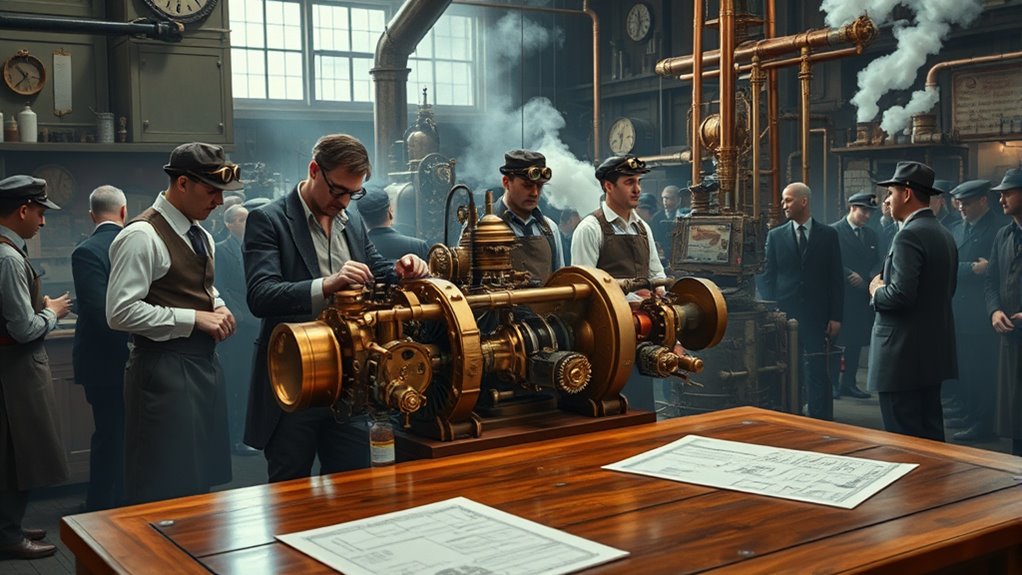
While exploring social hierarchies in the steampunk world, you'll find a complex interplay of class divisions shaped by economic disparities and technological access.
Wealthy elites often control advanced technologies, leaving the working class to face labor exploitation and social unrest. Despite rigid structures, characters may navigate these hierarchies through innovation and strategic alliances. The impact of technology further deepens divides, as only a privileged few can afford its benefits. Understanding social roles and historical context informs character development, adding depth to their motivations and actions.
You'll also encounter reform movements, where characters advocate for change, challenging oppressive regimes and societal norms. As traditional values clash with rapid advancements, cultural tensions arise, reflecting the complexities of a society caught between nostalgia and progress.
Environmental Considerations in Steampunk Design

Environmental considerations in steampunk design are crucial, especially since the genre often romanticizes industrialization without addressing its ecological consequences. You need to acknowledge that steam engines and coal combustion significantly contribute to emissions and pollution, impacting air quality in urban areas. Efficient resource management becomes essential as extensive water use and rare materials strain supply chains. By improving steam engine efficiency and integrating alternative energy sources like solar or wind, you can reduce energy waste. Incorporating solar energy systems can further enhance sustainability by providing a clean alternative for powering steam engines. Innovative waste management systems must be implemented to minimize pollution and ensure urban cleanliness. Embracing sustainable innovations, such as recycling and eco-friendly materials, allows you to create steampunk designs that harmonize with the environment, promoting a responsible approach to engineering in this imaginative world. Co-founding Leartes Studios has enabled the exploration of these concepts in a practical context, further emphasizing the importance of sustainability in design.
The Role of Craftsmanship and Community in Steampunk

Craftsmanship and community are at the heart of the steampunk movement, driving innovation and creativity among enthusiasts. You'll find vibrant steampunk communities thriving at social gatherings and events, where you can share and showcase your creations. Workshops and conventions offer great opportunities to enhance your craftsmanship skills and network with fellow enthusiasts. Online forums and social media platforms, like Instagram and Facebook, help you discuss ideas, share tutorials, and critique projects, further refining your work. Engaging with curiosity-driven exploration can lead to unexpected breakthroughs in your artistic process. Collaborative projects often involve multiple artists, sparking innovation and improvement. By engaging in metalworking, mixed media art, and vintage sourcing, you can create unique pieces that reflect the rich history of steampunk. Additionally, many artists incorporate Dusty Attic Steampunk Chippies into their mixed media projects, adding depth and texture to their creations. Ultimately, it's the shared passion that fuels this artistic journey, and understanding emotional dysregulation can enhance collaboration and communication within these creative communities.
Frequently Asked Questions
What Are the Key Differences Between Steampunk and Traditional Engineering?
When you compare steampunk and traditional engineering, you'll notice some key differences.
Steampunk relies on steam power and intricate mechanical systems, while traditional engineering often embraces electricity and modern materials.
You'll find steampunk designs are imaginative and whimsical, blending historical aesthetics with futuristic elements, unlike the practicality of traditional engineering.
Additionally, steampunk encourages creative problem-solving, focusing on the artistic expression of technology, rather than just efficiency and functionality.
How Do Steampunk Artists Source Materials for Their Creations?
When you dive into creating Steampunk art, think of it as a treasure hunt for unique materials.
You can scour craft stores for new metal parts, hit up flea markets for vintage finds, or explore local workshops for old mechanical bits.
Don't overlook online marketplaces like Etsy, where you can discover specific components.
Repurposing household items, like old clocks, gives your creations character and authenticity, making your projects truly one-of-a-kind.
What Role Does Humor Play in Steampunk Design?
Humor plays a crucial role in steampunk design by infusing whimsy and creativity.
You'll find that it blends Victorian aesthetics with modern wit, making creations both playful and thought-provoking.
By incorporating satire, designers critique industrialization while highlighting the absurdity of merging old and new technologies.
This humorous approach not only engages audiences but also inspires your imagination, inviting you to explore a unique perspective within the steampunk genre.
Are There Modern Steampunk Inventions Being Used Today?
Imagine a world where your laptop looks like a Victorian music box, and your coffee machine sounds like a steam engine chugging to life.
Modern steampunk inventions like these aren't just for show; they're used daily! You'll find steampunk watches ticking away, steam-powered robots roaming maker fairs, and even quirky furniture that sparks conversation.
It's a delightful mash-up of old and new, proving that creativity knows no bounds—even in the age of technology!
How Can I Get Involved in the Steampunk Community?
To get involved in the steampunk community, start by attending local conventions or events.
Join online forums and social media groups where you can share your interests and connect with others.
Explore crafting workshops to enhance your skills and contribute to the vibrant culture.
Don't hesitate to create your own steampunk-inspired art or fashion pieces.
Engaging in discussions and collaborations will help you feel at home in this diverse and welcoming community.
Conclusion
In the mesmerizing world of steampunk engineering, creativity collides with craftsmanship, crafting captivating contraptions that charm and challenge. You've explored the evolution of steam power, airships, and automatons, each element echoing an enchanting era. As you dive into this delightful domain, consider the culture, community, and conscious choices that shape its unique universe. Steampunk isn't just a style; it's a spirited symphony of imagination and innovation, inviting you to join the journey of joyous invention.
